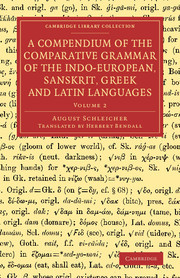Description
A Compendium of the Comparative Grammar of the Indo-European, Sanskrit, Greek and Latin Languages: Volume 2
Cambridge Library Collection - Linguistics Series
Author: Schleicher August
This 1874–7 abridged translation made Schleicher's groundbreaking work on Indo-European historical phonology and morphology accessible to English-speaking Classics students.
Language: English
Subject for A Compendium of the Comparative Grammar of the...:
Approximative price 25.06 €
In Print (Delivery period: 14 days).
Add to cart
Publication date: 09-2014
116 p. · 14x21.6 cm · Paperback
116 p. · 14x21.6 cm · Paperback
Description
/li>Contents
/li>
August Schleicher (1821?68) is often credited with being the first scholar to apply a 'family tree' model to language groups. He had published extensively on individual European languages before his groundbreaking comparative Indo-European Compendium (also reissued in this series) appeared in German in 1861?2. The book was derived from his lectures, and was intended to save his students note-taking and copying from the blackboard. Each section begins with his reconstruction of a Proto-Indo-European phonological or morphological feature, and then shows how this is reflected in a range of daughter languages. This abridged English translation, based on the German third edition, appeared in 1874?7. Produced for students of Greek and Latin philology, it focuses on the phonology and morphology of 'the original Indo-European language', Sanskrit, Greek and Latin, omitting Schleicher's extensive discussion of other languages and the comparative paradigms provided in the German edition. Volume 2 covers morphology.
Part II. Morphology: 1. The formation of derived verb-stems; 2. Those noun-stems most closely allied to verb-stems; 3. Formation of comparative and superlative stems; 4. Stems of the numerals.
© 2024 LAVOISIER S.A.S.




